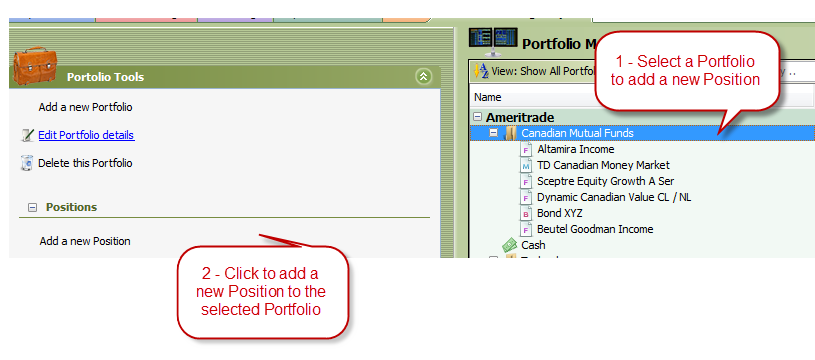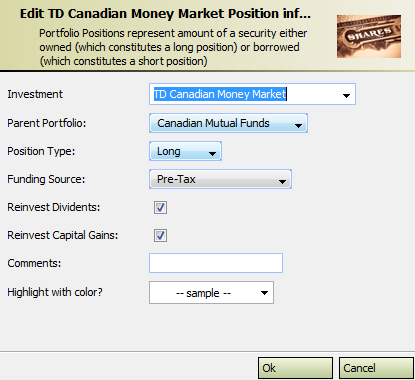Investments Positions
From MTHWiki
My Money 2.0 Manual | Portfolios<<Previous | Next>>Work with an individual investment
Contents |
Overview
Portfolio Position is a a collection of information about a security that is held in the Portfolio. If a security is owned then the Position is classified as a long position, if a security is owed then the position is classified as a short position.
Each position contains collection of the position's transaction history as well as ticker exchange and symbol for a stock, mutual fund, or other security, along with the number of units of that security that is held.
Creating Positions
You can create a new Portfolio Position in one of the following ways:
- Through Add a New Position link on the Positions Navigator
- Create New or Edit an existing Investment transaction, in the Investment part of the transaction type in a new Position Name. MyMoney will popup a Add New Security dialog that you can use to register a new security. Once you done with it a new empty position in this security will be created. You can edit it later to provide more details if needed.
Managing Positions
Editing Position Information
To Edit Position information, such as its name, parent Portfolio, funding sources, etc please use Edit Position Details link on the Positions Navigator
Editing Position Metrics
You can't directly create, update, or delete position metrics; Positions are calculated from investment transactions. For example, a AAPL position is derived from the buy and sell transactions for AAPL. MyMoney updates the position every time it receives a transaction for that position.
Therefore, to create or modify a position, send appropriate transactions on that position. To delete a position, first delete all of its transactions.
Selling all of the shares in a position does not delete the position; it just sets the position's value to zero.
Once the transactions are removed from a position you can physically delete position by clicking on Delete this Position link on the Positions Navigator
Short Positions
To record a short position, simply record a sell transaction first. While the short position is open you will own a negative number of shares. If the share price of the security goes down, your investment value will become less negative, thus the value will be increasing. When the position is closed, record the corresponding purchase.
To keep your total portfolio value correct, use the default cash account option and transfer the proceeds of your initial sell into your cash investment.
Example Short Position
Assume you shorted 100 shares of IBM at $90/share. Record a sell of 100 shares at $90 in a IBM investment.
Your cash account will increase in value by $9000. The total change in your initial portfolio value is $0, as the value of your IBM investment is $ -9,000.
If IBM goes down to $80/share, your portfolio will increase in value by $1,000, as the cash account still has a plus $9,000 value,
and the IBM value will have increased to $ -8,000.
When you close the short position, record a purchase of 100 shares of IBM, for the amount you paid to buy back the originally shorted shares.
My Money 2.0 Manual | Portfolios<<Previous | Next>>Work with an individual investment



